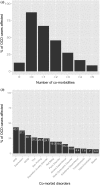A trans-diagnostic perspective on obsessive-compulsive disorder
- PMID: 28343453
- PMCID: PMC5964477
- DOI: 10.1017/S0033291716002786
A trans-diagnostic perspective on obsessive-compulsive disorder
Abstract
Progress in understanding the underlying neurobiology of obsessive-compulsive disorder (OCD) has stalled in part because of the considerable problem of heterogeneity within this diagnostic category, and homogeneity across other putatively discrete, diagnostic categories. As psychiatry begins to recognize the shortcomings of a purely symptom-based psychiatric nosology, new data-driven approaches have begun to be utilized with the goal of solving these problems: specifically, identifying trans-diagnostic aspects of clinical phenomenology based on their association with neurobiological processes. In this review, we describe key methodological approaches to understanding OCD from this perspective and highlight the candidate traits that have already been identified as a result of these early endeavours. We discuss how important inferences can be made from pre-existing case-control studies as well as showcasing newer methods that rely on large general population datasets to refine and validate psychiatric phenotypes. As exemplars, we take 'compulsivity' and 'anxiety', putatively trans-diagnostic symptom dimensions that are linked to well-defined neurobiological mechanisms, goal-directed learning and error-related negativity, respectively. We argue that the identification of biologically valid, more homogeneous, dimensions such as these provides renewed optimism for identifying reliable genetic contributions to OCD and other disorders, improving animal models and critically, provides a path towards a future of more targeted psychiatric treatments.
Keywords: ERN; OCD; RDoC; goal-directed; trans-diagnostic.
Figures



Similar articles
-
Comparison of the Association Between Goal-Directed Planning and Self-reported Compulsivity vs Obsessive-Compulsive Disorder Diagnosis.JAMA Psychiatry. 2020 Jan 1;77(1):77-85. doi: 10.1001/jamapsychiatry.2019.2998. JAMA Psychiatry. 2020. PMID: 31596434 Free PMC article.
-
Does obsessive-compulsive personality disorder belong within the obsessive-compulsive spectrum?CNS Spectr. 2007 Jun;12(6):467-82. doi: 10.1017/s1092852900015340. CNS Spectr. 2007. PMID: 17545957 Review.
-
Role of the dorsal anterior cingulate cortex in obsessive-compulsive disorder: converging evidence from cognitive neuroscience and psychiatric neurosurgery.J Neurosurg. 2017 Jan;126(1):132-147. doi: 10.3171/2016.1.JNS15601. Epub 2016 Apr 1. J Neurosurg. 2017. PMID: 27035167
-
Obsessive-compulsive spectrum disorders in obsessive-compulsive disorder and other anxiety disorders.Psychopathology. 2010;43(6):389-96. doi: 10.1159/000321070. Epub 2010 Sep 16. Psychopathology. 2010. PMID: 20847586
-
Compulsivity in obsessive-compulsive disorder and addictions.Eur Neuropsychopharmacol. 2016 May;26(5):856-68. doi: 10.1016/j.euroneuro.2015.12.003. Epub 2015 Dec 11. Eur Neuropsychopharmacol. 2016. PMID: 26774279 Review.
Cited by
-
The Error-Related Negativity Predicts Self-Control Failures in Daily Life.Front Hum Neurosci. 2021 Jan 27;14:614979. doi: 10.3389/fnhum.2020.614979. eCollection 2020. Front Hum Neurosci. 2021. PMID: 33584226 Free PMC article.
-
Latent traits of impulsivity and compulsivity: toward dimensional psychiatry.Psychol Med. 2018 Apr;48(5):810-821. doi: 10.1017/S0033291717002185. Epub 2017 Aug 14. Psychol Med. 2018. PMID: 28805173 Free PMC article.
-
The prefrontal cortex and OCD.Neuropsychopharmacology. 2022 Jan;47(1):211-224. doi: 10.1038/s41386-021-01130-2. Epub 2021 Aug 16. Neuropsychopharmacology. 2022. PMID: 34400778 Free PMC article. Review.
-
Damage to the dorsolateral prefrontal cortex is associated with repetitive compulsive behaviors in patients with penetrating brain injury.BMJ Neurol Open. 2022 Apr 18;4(1):e000229. doi: 10.1136/bmjno-2021-000229. eCollection 2022. BMJ Neurol Open. 2022. PMID: 35519903 Free PMC article.
-
Obsessive-Compulsive Disorder from an Embodied Cognition Perspective.Noro Psikiyatr Ars. 2022 Dec 16;59(Suppl 1):S50-S56. doi: 10.29399/npa.28151. eCollection 2022. Noro Psikiyatr Ars. 2022. PMID: 36578983 Free PMC article. Review.
References
-
- Aarts K, Vanderhasselt MA, Otte G, Baeken C, Pourtois G (2013). Electrical brain imaging reveals the expression and timing of altered error monitoring functions in major depression. Journal of Abnormal Psychology 122, 939–950. - PubMed
-
- Adams CD (1982). Variations in the sensitivity of instrumental responding to reinforcer devaluation. Quarterly Journal of Experimental Psychology, Section B: Comparative and Physiological Psychology 34, 77–98.
Publication types
MeSH terms
Grants and funding
LinkOut - more resources
Full Text Sources
Other Literature Sources
Medical
Research Materials

